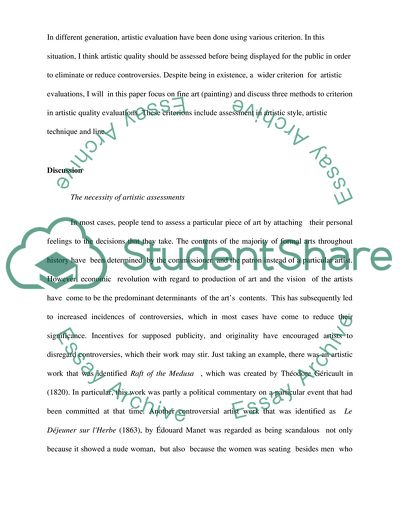Cite this document
(“Assessment of Artistic Quality Essay Example | Topics and Well Written Essays - 3250 words”, n.d.)
Assessment of Artistic Quality Essay Example | Topics and Well Written Essays - 3250 words. Retrieved from https://studentshare.org/visual-arts-film-studies/1631758-please-discuss-your-views-on-whether-artistic-quality-should-be-assessed-or-not-if-you-agree-that-it-should-be-assessed-please-identify-the-assessment-criteria-that-you-think-are-applicable-and-explain-the-reasons-for-these-choices
Assessment of Artistic Quality Essay Example | Topics and Well Written Essays - 3250 words. Retrieved from https://studentshare.org/visual-arts-film-studies/1631758-please-discuss-your-views-on-whether-artistic-quality-should-be-assessed-or-not-if-you-agree-that-it-should-be-assessed-please-identify-the-assessment-criteria-that-you-think-are-applicable-and-explain-the-reasons-for-these-choices
(Assessment of Artistic Quality Essay Example | Topics and Well Written Essays - 3250 Words)
Assessment of Artistic Quality Essay Example | Topics and Well Written Essays - 3250 Words. https://studentshare.org/visual-arts-film-studies/1631758-please-discuss-your-views-on-whether-artistic-quality-should-be-assessed-or-not-if-you-agree-that-it-should-be-assessed-please-identify-the-assessment-criteria-that-you-think-are-applicable-and-explain-the-reasons-for-these-choices.
Assessment of Artistic Quality Essay Example | Topics and Well Written Essays - 3250 Words. https://studentshare.org/visual-arts-film-studies/1631758-please-discuss-your-views-on-whether-artistic-quality-should-be-assessed-or-not-if-you-agree-that-it-should-be-assessed-please-identify-the-assessment-criteria-that-you-think-are-applicable-and-explain-the-reasons-for-these-choices.
“Assessment of Artistic Quality Essay Example | Topics and Well Written Essays - 3250 Words”, n.d. https://studentshare.org/visual-arts-film-studies/1631758-please-discuss-your-views-on-whether-artistic-quality-should-be-assessed-or-not-if-you-agree-that-it-should-be-assessed-please-identify-the-assessment-criteria-that-you-think-are-applicable-and-explain-the-reasons-for-these-choices.


